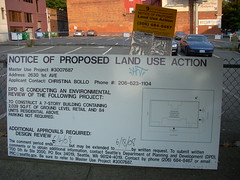In thousands of planning and zoning laws across the nation, official announcements are required to be published in the local newspaper of "general circulation." In an era of newspaper decline and expanding diversity of media, are these laws becoming obsolete? Furthermore, should we be concerned with newspapers at all if a newer, more universally accessible medium is available: the Internet? A variety of announcements are legally required to be published in a local periodical of "general circulation," sometimes in addition to being published in an official government gazette. The practice entered the planning world through the U.S. Department of Commerce's highly influential standard zoning and planning enabling acts.
In thousands of planning and zoning laws across the nation, official announcements are required to be published in the local newspaper of "general circulation." In an era of newspaper decline and expanding diversity of media, are these laws becoming obsolete? Furthermore, should we be concerned with newspapers at all if a newer, more universally accessible medium is available: the Internet?
A variety of announcements are legally required to be published in a local periodical of "general circulation," sometimes in addition to being published in an official government gazette. The practice entered the planning world through the U.S. Department of Commerce's highly influential standard zoning and planning enabling acts.
The standard zoning act required any zoning amendment be heard before a public meeting, and "at least 15 days' notice of the time and place of such hearing shall be published in an official paper, or a paper of general circulation, in such municipality." The planning act's language was similar, requiring before a new plan could be adopted a "notice of the time and place of which shall be given by one publication in a newspaper of general circulation in the municipality and in the official gazette, if any, of the municipality."
 Published in 1926 and 1928, these acts influenced subsequent state laws across the nation. State and local laws often take a number of additional approaches to ensure the public has a reasonable opportunity to be heard in these proceedings. They include physical signs (such as this one from Seattle), notices posted on a prominent spot at city hall, or mailings to adjoining or other property owners.
Published in 1926 and 1928, these acts influenced subsequent state laws across the nation. State and local laws often take a number of additional approaches to ensure the public has a reasonable opportunity to be heard in these proceedings. They include physical signs (such as this one from Seattle), notices posted on a prominent spot at city hall, or mailings to adjoining or other property owners.
However, among these, the requirement to publish in a newspaper is unique in its reach. Regular citizens may not pass by every property or even visit city hall, but many will subscribe to the newspaper. Historically the term "general circulation" has evaded close definition, perhaps since in most communities tradition has established what local paper qualifies - usually a general daily or weekly. Citing two cases, an Indiana state legal memorandum defined the term as referring to papers with a diversity of subscribers, not simply a high circulation.
This means that although many newspapers are suffering declining relevance and circulation, their status as general circulation publications is not in danger so far as the law is concerned. However, I propose a new approach to public notice: the Internet. The Internet is available at any time and place there is a connection. Access in public schools and libraries is nearly universal. Additionally, it has fast become the resource of first resort for a wide variety of citizens. Although not every citizen may have access to the Internet, I have argued before that putting information on the web can raise the general level of awareness by improving the knowledge of journalists, activists, civic leaders, and others who are engaged in disseminating information.
Although many governments do a good job making information available, the quality is unfortunately uneven and many communities do not post information in a timely way. (In June I discussed this fact in the context of a related argument governments should focus on providing data only.) Requiring online notices in addition to or in the place of newspaper ads through a state law will ensure uniformity, and harness new technology to capture the intent of our existing planning and zoning laws in a changing world.

Planetizen Federal Action Tracker
A weekly monitor of how Trump’s orders and actions are impacting planners and planning in America.

Chicago’s Ghost Rails
Just beneath the surface of the modern city lie the remnants of its expansive early 20th-century streetcar system.

Amtrak Cutting Jobs, Funding to High-Speed Rail
The agency plans to cut 10 percent of its workforce and has confirmed it will not fund new high-speed rail projects.

Ohio Forces Data Centers to Prepay for Power
Utilities are calling on states to hold data center operators responsible for new energy demands to prevent leaving consumers on the hook for their bills.

MARTA CEO Steps Down Amid Citizenship Concerns
MARTA’s board announced Thursday that its chief, who is from Canada, is resigning due to questions about his immigration status.

Silicon Valley ‘Bike Superhighway’ Awarded $14M State Grant
A Caltrans grant brings the 10-mile Central Bikeway project connecting Santa Clara and East San Jose closer to fruition.
Urban Design for Planners 1: Software Tools
This six-course series explores essential urban design concepts using open source software and equips planners with the tools they need to participate fully in the urban design process.
Planning for Universal Design
Learn the tools for implementing Universal Design in planning regulations.
Caltrans
City of Fort Worth
Mpact (founded as Rail~Volution)
City of Camden Redevelopment Agency
City of Astoria
City of Portland
City of Laramie



























